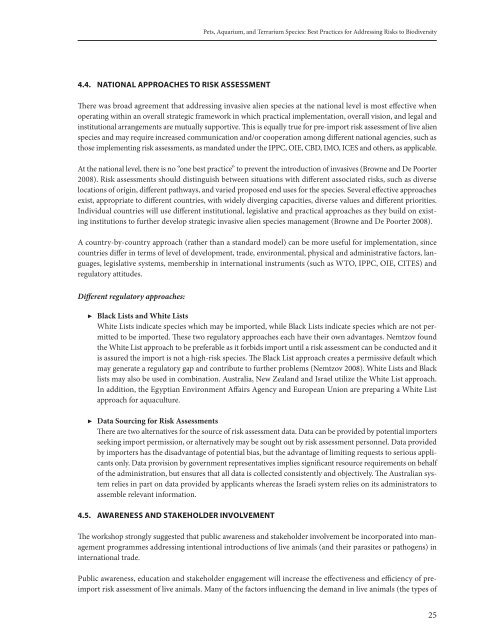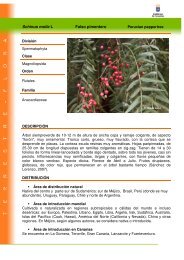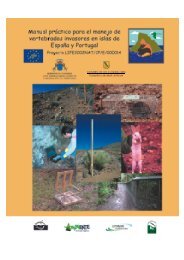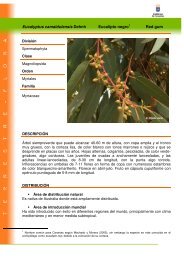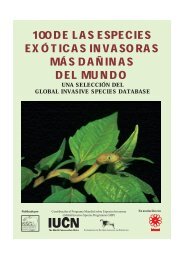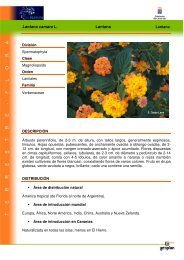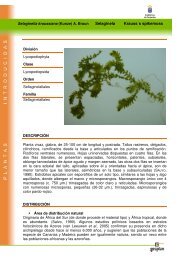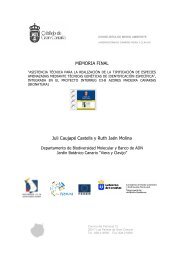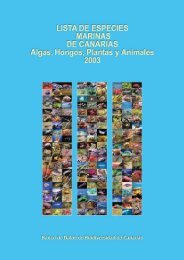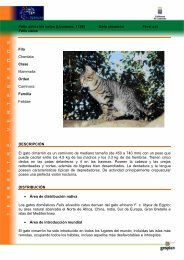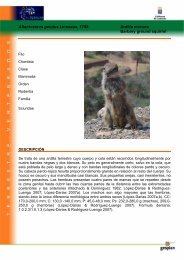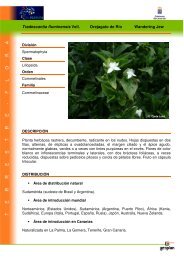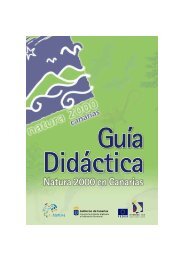Pets, Aquarium, and Terrarium Species - Convention on Biological ...
Pets, Aquarium, and Terrarium Species - Convention on Biological ...
Pets, Aquarium, and Terrarium Species - Convention on Biological ...
Create successful ePaper yourself
Turn your PDF publications into a flip-book with our unique Google optimized e-Paper software.
<str<strong>on</strong>g>Pets</str<strong>on</strong>g>, <str<strong>on</strong>g>Aquarium</str<strong>on</strong>g>, <str<strong>on</strong>g>and</str<strong>on</strong>g> <str<strong>on</strong>g>Terrarium</str<strong>on</strong>g> <str<strong>on</strong>g>Species</str<strong>on</strong>g>: Best Practices for Addressing Risks to Biodiversity<br />
4.4. Nati<strong>on</strong>al Approaches to Risk Assessment<br />
There was broad agreement that addressing invasive alien species at the nati<strong>on</strong>al level is most effective when<br />
operating within an overall strategic framework in which practical implementati<strong>on</strong>, overall visi<strong>on</strong>, <str<strong>on</strong>g>and</str<strong>on</strong>g> legal <str<strong>on</strong>g>and</str<strong>on</strong>g><br />
instituti<strong>on</strong>al arrangements are mutually supportive. This is equally true for pre-import risk assessment of live alien<br />
species <str<strong>on</strong>g>and</str<strong>on</strong>g> may require increased communicati<strong>on</strong> <str<strong>on</strong>g>and</str<strong>on</strong>g>/or cooperati<strong>on</strong> am<strong>on</strong>g different nati<strong>on</strong>al agencies, such as<br />
those implementing risk assessments, as m<str<strong>on</strong>g>and</str<strong>on</strong>g>ated under the IPPC, OIE, CBD, IMO, ICES <str<strong>on</strong>g>and</str<strong>on</strong>g> others, as applicable.<br />
At the nati<strong>on</strong>al level, there is no “<strong>on</strong>e best practice” to prevent the introducti<strong>on</strong> of invasives (Browne <str<strong>on</strong>g>and</str<strong>on</strong>g> De Poorter<br />
2008). Risk assessments should distinguish between situati<strong>on</strong>s with different associated risks, such as diverse<br />
locati<strong>on</strong>s of origin, different pathways, <str<strong>on</strong>g>and</str<strong>on</strong>g> varied proposed end uses for the species. Several effective approaches<br />
exist, appropriate to different countries, with widely diverging capacities, diverse values <str<strong>on</strong>g>and</str<strong>on</strong>g> different priorities.<br />
Individual countries will use different instituti<strong>on</strong>al, legislative <str<strong>on</strong>g>and</str<strong>on</strong>g> practical approaches as they build <strong>on</strong> existing<br />
instituti<strong>on</strong>s to further develop strategic invasive alien species management (Browne <str<strong>on</strong>g>and</str<strong>on</strong>g> De Poorter 2008).<br />
A country-by-country approach (rather than a st<str<strong>on</strong>g>and</str<strong>on</strong>g>ard model) can be more useful for implementati<strong>on</strong>, since<br />
countries differ in terms of level of development, trade, envir<strong>on</strong>mental, physical <str<strong>on</strong>g>and</str<strong>on</strong>g> administrative factors, languages,<br />
legislative systems, membership in internati<strong>on</strong>al instruments (such as WTO, IPPC, OIE, CITES) <str<strong>on</strong>g>and</str<strong>on</strong>g><br />
regulatory attitudes.<br />
Different regulatory approaches:<br />
▶▶<br />
Black Lists <str<strong>on</strong>g>and</str<strong>on</strong>g> White Lists<br />
White Lists indicate species which may be imported, while Black Lists indicate species which are not permitted<br />
to be imported. These two regulatory approaches each have their own advantages. Nemtzov found<br />
the White List approach to be preferable as it forbids import until a risk assessment can be c<strong>on</strong>ducted <str<strong>on</strong>g>and</str<strong>on</strong>g> it<br />
is assured the import is not a high-risk species. The Black List approach creates a permissive default which<br />
may generate a regulatory gap <str<strong>on</strong>g>and</str<strong>on</strong>g> c<strong>on</strong>tribute to further problems (Nemtzov 2008). White Lists <str<strong>on</strong>g>and</str<strong>on</strong>g> Black<br />
lists may also be used in combinati<strong>on</strong>. Australia, New Zeal<str<strong>on</strong>g>and</str<strong>on</strong>g> <str<strong>on</strong>g>and</str<strong>on</strong>g> Israel utilize the White List approach.<br />
In additi<strong>on</strong>, the Egyptian Envir<strong>on</strong>ment Affairs Agency <str<strong>on</strong>g>and</str<strong>on</strong>g> European Uni<strong>on</strong> are preparing a White List<br />
approach for aquaculture.<br />
▶▶<br />
Data Sourcing for Risk Assessments<br />
There are two alternatives for the source of risk assessment data. Data can be provided by potential importers<br />
seeking import permissi<strong>on</strong>, or alternatively may be sought out by risk assessment pers<strong>on</strong>nel. Data provided<br />
by importers has the disadvantage of potential bias, but the advantage of limiting requests to serious applicants<br />
<strong>on</strong>ly. Data provisi<strong>on</strong> by government representatives implies significant resource requirements <strong>on</strong> behalf<br />
of the administrati<strong>on</strong>, but ensures that all data is collected c<strong>on</strong>sistently <str<strong>on</strong>g>and</str<strong>on</strong>g> objectively. The Australian system<br />
relies in part <strong>on</strong> data provided by applicants whereas the Israeli system relies <strong>on</strong> its administrators to<br />
assemble relevant informati<strong>on</strong>.<br />
4.5. Awareness <str<strong>on</strong>g>and</str<strong>on</strong>g> Stakeholder Involvement<br />
The workshop str<strong>on</strong>gly suggested that public awareness <str<strong>on</strong>g>and</str<strong>on</strong>g> stakeholder involvement be incorporated into management<br />
programmes addressing intenti<strong>on</strong>al introducti<strong>on</strong>s of live animals (<str<strong>on</strong>g>and</str<strong>on</strong>g> their parasites or pathogens) in<br />
internati<strong>on</strong>al trade.<br />
Public awareness, educati<strong>on</strong> <str<strong>on</strong>g>and</str<strong>on</strong>g> stakeholder engagement will increase the effectiveness <str<strong>on</strong>g>and</str<strong>on</strong>g> efficiency of preimport<br />
risk assessment of live animals. Many of the factors influencing the dem<str<strong>on</strong>g>and</str<strong>on</strong>g> in live animals (the types of<br />
25


